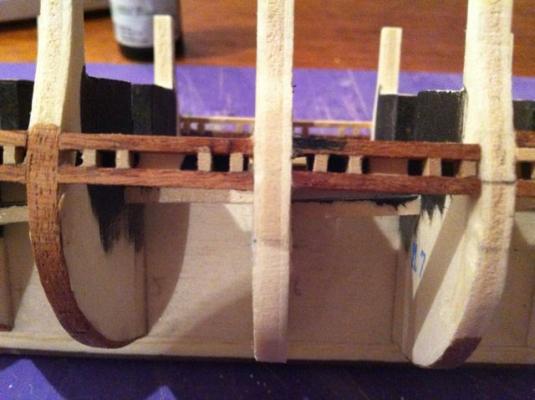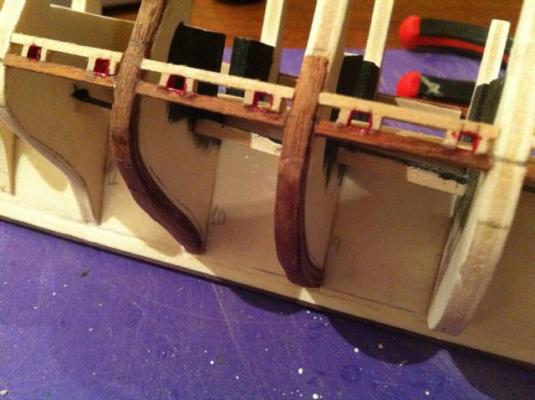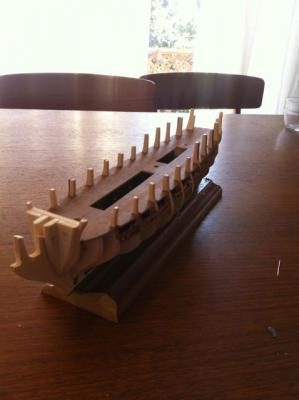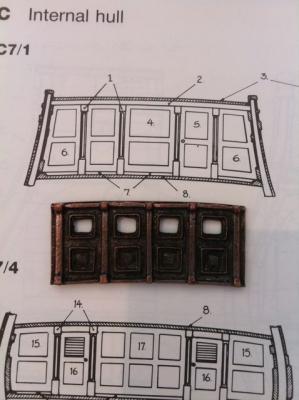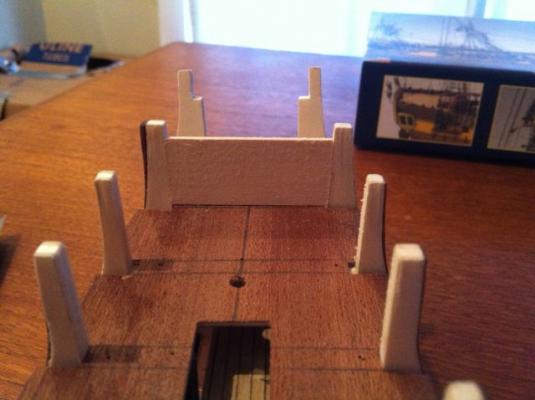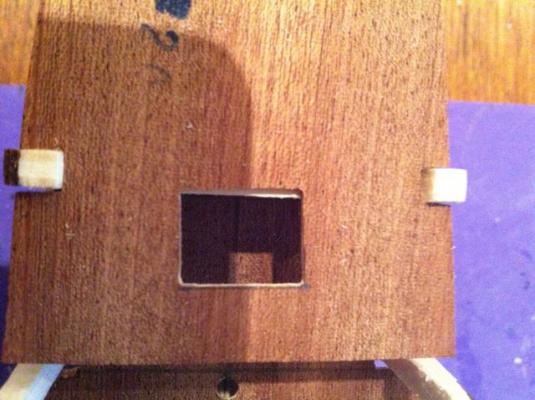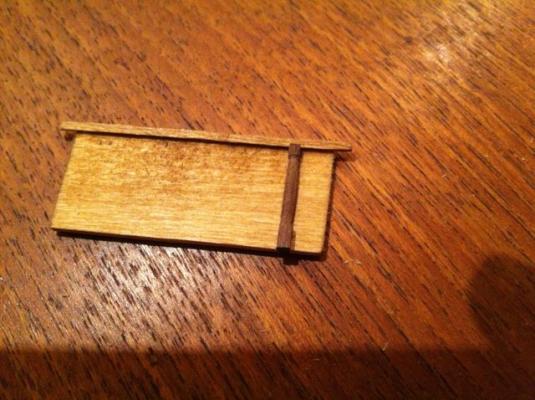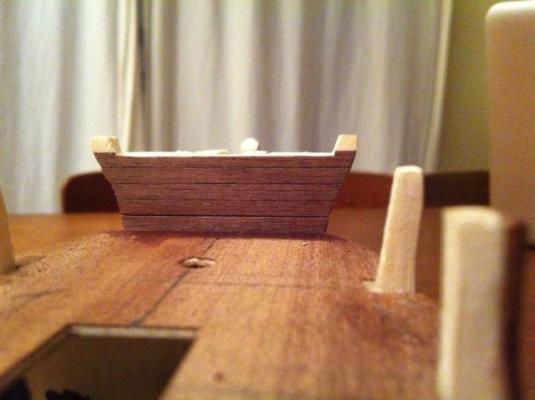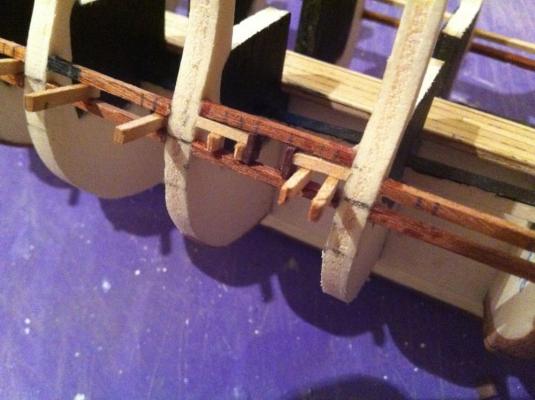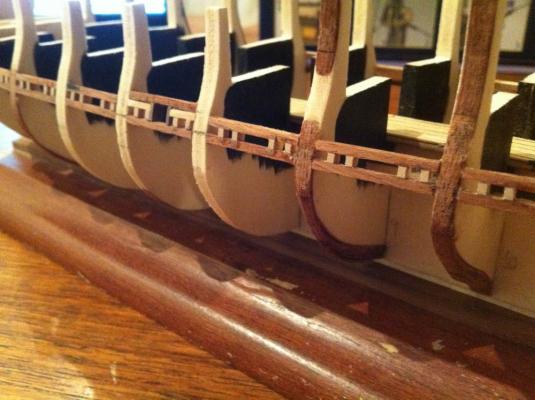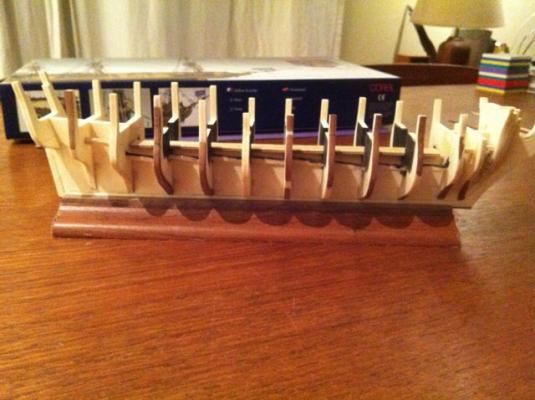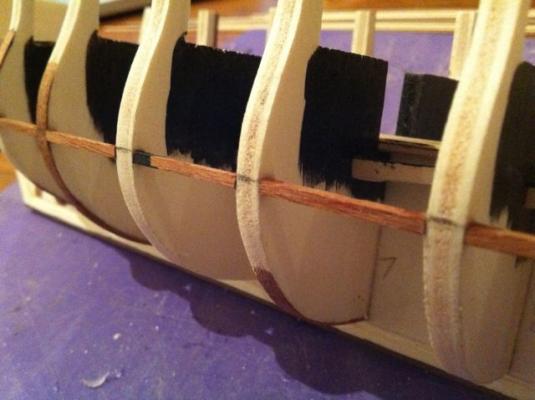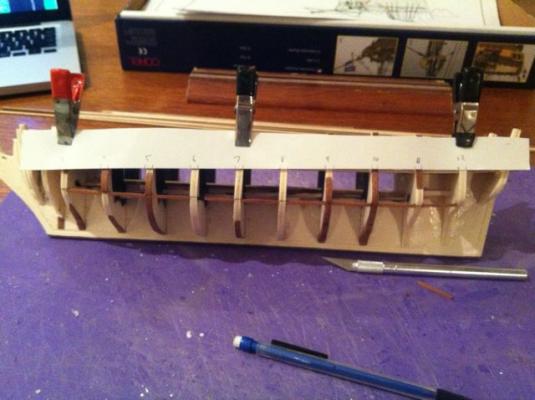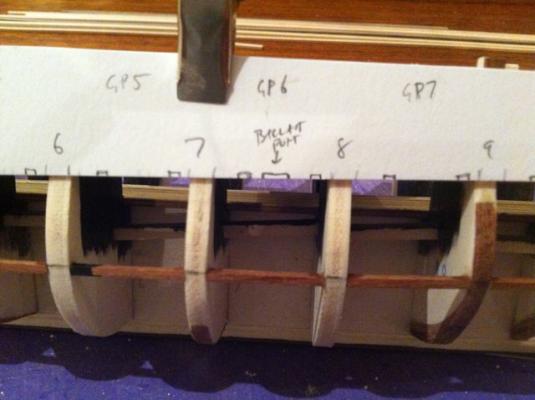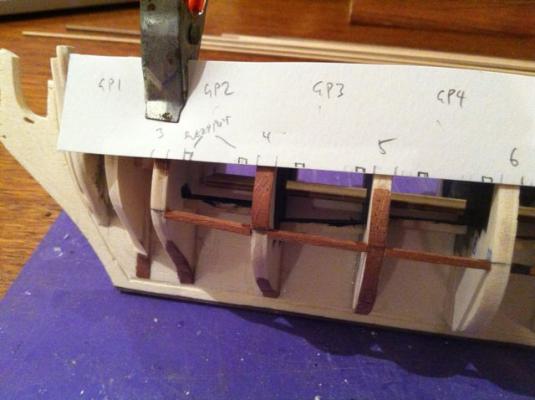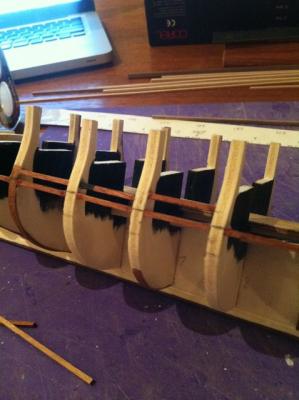-
Posts
1,931 -
Joined
-
Last visited
Content Type
Profiles
Forums
Gallery
Events
Everything posted by hamilton
-
Beautiful work, as usual, Augie! hamilton
- 1,668 replies
-
- syren
- model shipways
-
(and 1 more)
Tagged with:
-
Alright - another update after some time. To tell the truth, I have had only a little motivation lately to work on the build - perhaps it's the nice weather here, perhaps it's the nature of this kit....who knows. Also my mother-in-law's in town, so there are family commitments that have kept me away from the "bench". Here's what I've done since last post -- added backings to the sweep ports so that I can later fix the faux sweeps in them - my son helped me paint these black -- painted the inside of the sweep frames red (I didn't have an appropriate brush so I used a toothpick - my sone helped here, too (at 2mm x 2mm, these were quite finicky and I only remembered to do it after the backing had already beed added on one side... -- installed the main deck - though I have to trim the edges, and I kind of wish I had done this while the thing was not fixed on the framework....Hopefully I can make the necessary adjustments during the fairing. -- scratch built a cabin bulkhead following Goodwin's drawing in the Blandford book - here are the stages 1. I made a template from the Goodwin book and traced the outline onto a 1/16 sheet of basswood. I then cut the basswood out and shaped it to fit between the extensions of bulkhead 12 and so that it was flush against the main and quarterdecks - I decided to fit it flush across the forward edges of the extensions and build the cabin bulkhead across both the piece I made and the extensions. 2. After dry-fitting the quarterdeck, I noticed that there was an issue with the quarterdeck ladder hatch - as you can see..... 3. The grain on the quarterdeck ply is on an angle, but the hole for the ladder hatch is also off plumb. I shimmed it at the back to compensate for the scratch-built cabin bulkhead, and then also filed it out forward a bit to keep the dimensions and straighten it out - no photo of this - sorry 4. I first fit a piece across the top to simulate a deck beam - this marks the top of the pillars, doors and panels. I made the pillars (4 in total) out of 2mm x 2mm walnut, rounding a section through the pillar and leaving a square base and head... 5. I then used .5mm x 3mm walnut cut in half (to 1.5mm width) to make the door and panel frames and 1mm x 1mm to make the molding at the bottom. You can see I've stained the bulkhead extensions, but being a different wood they're a bit contrasty. A brass nail simulates the knob...I'd run out of blacken-it, so I've left it brass. 6. I then installed the bulkhead and built up the two outboard panels after installation, since they run across the seam between the piece I made and the bulkhead extensions. I'm fine with the port side one, but you can see that the starboard side one looks very clumsy - I rushed it at a time when I was also not entirely in a modelling head space...I will have to re-do it.... Anyway, you get the impression. -- the final thing I've done is to plank the aft face of bulkhead 1. I'm not sure how much this will add to the look of the thing, but it seemed to me that the bulkhead would be visible under the forecastle - even with the half-bulkheads I plan on adding. So I thought to be safe I'd plank it - .5mm x 3mm walnut for this. So now I have a question - I'm planning on painting the inboard bulwarks red. But I had thought to leave the cabin bulkhead & half f'csl bulkheads natural wood....wondering what people's opinion on this might be....I've seen period builds that either leave all natural or paint all red, but I've not seen any that have red bulwarks and natural wood cabin bulkheads....if there are no objections, I might just go ahead...... hamilton
-
Hi Harlequin: I must have missed the update! Thanks for the info on the rigging line - I purchased some black rigging thread in appropriate sizes from model expo, though their line (vinyl) is not the best. Anyway, your rigging looks great - it really brings the model to life - can't wait to see some shots of the completed ship. As a suggestion - try taking a few photos outside if you get a nice blue-sky day - good for picking up details. Bye for now hamilton
-
Absolutely beautiful work!! And a very intriguing ship! I love the scratch work you've done. Can I ask - are the plans very detailed? hamilton
-
Ha ha!! you're making me anxious, Augie! If you're talking about the Syren, then it will not be so far in the future I'll be making 120 of something! Anyway - I just took a peek into your Syren build log - it seems I have to check there every day if I'm to keep up - not only with the build, but with the flurry of jokes and banter! There's a whole society in there! I'm almost afraid to post there! hamilton
-
Hi Robbyn: Just catching up on your build log after a long absence - wow! Great recovery from the injury and great work on the SF! Glad to see you diving into some scratch building on this build - I was much too timid to do so on my first! Also I'm glad you got that forward cannon on. My 4-year-old son made me take it off on my SF build because he was afraid someone would trip over it coming down the stairs! I've been trying to sneak it back on ever since, but he keeps catching me at it! Sheesh! hamilton
- 773 replies
-
- san francisco ii
- artesania latina
-
(and 1 more)
Tagged with:
-
Well I've nearly finished with the sweep port framing. The frames themselves are done, but I need to install a backing for them (painted black) so that I can set the actual sweeps in later - which will be the last thing I do on the model. At 1:100 scale the sweeps will be very thin and fragile so having them sticking out as I tie ratlines and rig braces is probably a bad idea. Anyway, I have to make 36 of them, which will probably drive me crazy! If I was an intelligent person, I might do one or two here and there as I go, starting now, so I can avoid losing my mind later..... Here's a shot of the ballast port on the port side, now fully framed. The only spare stock I could find that was 4mm wide (the height of the port) was some 1mm x 4mm walnut that was meant for the second planking of the Toulonnaise (I replaced that planking and now have a good supply of this material...) Here's a couple of shots showing how I made the vertical frames - I cut 1" lengths of 1.5mm x 2mm basswood and inserted it between the horizontal frames at the lines I'd marked. I did this first for the aft side of all the frames. Then I clipped the strips and used the leftover portion to frame the forward sides of the ports.... And here's how it looked after a good sanding - the port side finished. Both sides are finished now. Next steps will be, as I mentioned, to install the backing on the ports, fair the tops of the bulkheads for the main deck, install the main deck, and then scratch build the cabin bulkhead and half bulkheads beneath the forecastle...I have been debating whether to do these bulkheads now or wait until after the bulwarks are planked......Whether I install them or not, I will be building them this week....all this framing is driving me nuts, and it'll be nice to actual make something....Anyway, thanks for reading and happy modelling hamilton
-
Hi Harlequin: Yes I thought this one might be wide across the beam....It might be possible to bash it to reduce this dimension, but I'm not sure I have it in me to do that....Once the "big" ship is planked up I'll build the ship's boat and have a look see....but all that seems a very long way away....I'll be happy if I can get through the sweep port framing this weekend. How's the rugby season going? hamilton
-
Hello all: A quick update to show the beginning of the sweep port framing. I marked the waterline along the edge of each bulkhead. The sweep ports run parallel to the waterline, so I needed to establish that first. I then (stupidly) started installing the lower and upper frames along the waterline - WRONG! I should have measured up from the waterline the total width of the wales and then marked another set of lines there parallel to the waterline marks! Eventually I figured this out, undid about 2 hours worth of work and quickly did it again....made some small progress. Here's how it looked. First, here are a couple of shots of the completed shimming. Then, here are some of the frames installed wrong.... Here is a template I made to mark the bulkheads, so I could plot out the positioning of the sweep ports and the ballast ports. The sweep ports are 2mm x 2mm and are spaced 12.5mm apart beginning just fwd of gunport 2 and continuing aft - a total of 18 on each side. The ballast port is 5mm wide x 4mm high and is situated below gunport 6 at mid-ships port and starboard. Here are a couple of close-ups of the template to show where the sweep ports and ballast ports are marked. Now all these pictures feature the poorly positioned frames. Here is a final shot where the frames have been repositioned more correctly. They still seem a shade too low, but it is honestly very difficult to try to visualise how things will look once everything is planked up....if they turn out to seem loike a disaster, I will forget about them and just plank over....Anyway, I'll post again when this process is complete. I've now completed all the lower frames on the port side and (as you see) a few of the upper ones. Still the rest of the upper frames and all the tiny little vertical frames to go and then repeat starboard....Bye for now hamilton
-
Hi Harlequin: I'm not so sure....I don't mind the ratlines so much - throw on a few podcasts and settle in for some clove hitches....though on this one I think there will be more ratlines than I've ever done....I did close to 1000 on the San Francisco, but I think there might be a few more than that here.....chip away, chip away hamilton
-
Hi Augie: Yes, indeed - it's beginning to feel like I've spent forever on the framework - and there's a lot more to go! My one worry about the POF ship's boat is that its shape might not be exactly right for the type of boat it's supposed to be (a pinnace). I might find myself modifying it, as well!! hamilton
-
Well I've finally finished shimming the outboard bulkheads...phew! What a lot of tedious work! I'll post some pictures later. Next comes some more niggling, but also I think more interesting work - framing the sweeps & ballast ports. Here's how I'll approach it. 1. Identify the waterline and mark it along the outside edges of the bulkheads 2. Mark a point on each bulkhead a little less than mid-way between the false lower deck and the main deck defining a line that runs parallel to the waterline (this is the location of the sweep ports, which run parallel to the waterline) 3. Install 2mm x 2mm scrap wood along that line to mark the lower edge of the sweep ports/ballast ports 4. install another set of scrap wood strips 2mm above the first set - this is the top edge of the sweeps 5. install a pair of scrap wood strips 5mm above the first set of strips at a point corresponding to and below gunport 6 - this is the ballast port 6. add small pieces of scrap wood vertically between the two horizontal strips to mark out the sweep ports which should be 2mm square 7. add small pieces of scrap wood vertically to define the ballast ports (5mm x 4mm). Once this is done, I'll fix up the tops of the bulkheads and install the main deck. Then it's time for some serious fairing!! Good night to all hamilton
-
Hi there: So in looking through Goodwin's Anatomy of the Ship HMS Blandford, I've found a couple of clues (in different places) as to how to mount the ship's boat. Goodwin has an illustration on page 63 which shows the main sheet bitts fitted with a gallows. This resolves the aft mounting. Then on page 27, in the section with the photographic plates, there is a picture of a model from the NMM of a 20-gun 6th rate which is fitted with a gallows just forward of the fore hatch. Good thing I read the caption! hamilton
-
I'm with Augie on this - in the past I've often given up updating my build log when it comes to the rigging simply because I can't seem to get decent shots! I'll have to try this technique - it's looking great. By the way - I notice that you've got black standing rigging, though Corel only supplies hemp line....did you dye their line or did you replace it? If you replaced it, what did you use? I ended up ordering some of the usual Model Expo rigging line - not the best looking but easy to work with...I think that when I build the Bellona I'll order Morope to replace Corel's line - though I do like the Corel rigging line...... Anyway, looks like you're almost there! Looking great! hamilton
-
Hi B.E.: Thanks for the comment! Yes, this kit does beg for a good bashing. So far it's felt like most of the bashing has been my head against the wall! But with Goodwin's Anatomy of the Ship Blandford as a guide, I'm going to try to modify this kit quite a bit - as mentioned before, adding open bulwarks, adding sweep ports and sweeps, adjusting the belfry and f'csl rail, adding ladders to the f'csl, adjusting the rigging and belaying arrangement, etc. One thing that's been plaguing me is how to mount the ship's boat (which I'm also replacing with a 3.5" plank-on-frame boat from ME). Corel shows the boat mounted aft on a gallows bit and fwd on the base of the belfry, which is centred on the f'csl rail. But Goodwin shows the belfry off centre, which means that the forward positioning suggested by Corel is not going to work for me. Goodwin's book provided the solution - he shows the main sheet bits (which are not really included in Corel's kit at all but replaced by the gallows) fitted with a gallows up top. And then in the section of photographs, there is an example of an early model of a 20-gun 6th rate that has a gallows fitted forward (just in front of the forward hatch). So I'll be adding this as well.... Anyway, that's all for the future. After I finish shimming, the real bashing will begin - I'll frame out the sweep ports (2mm x 2mm - which will be quite tricky) and the 2 ballast ports (5mm x 4mm), fair the whole thing, and then start the first planking & building up the open bulwarks and re-doing the gunport frames....yikes! What have I got myself into! hamilton
-
Hi Augie: Thanks for stopping by! Yes there will be a lot of fairing to do - you probably noticed that the shimming on bulkheads 9 & 10 appears in the photo to be a little dippy...in reality it's not as bad as it looks on camera - it's just the angle. However, I've been rough fairing the bulkheads at the same time as I'm shimming so that I can try to get as accurate a run of planks as possible. The real fairing will begin after I install the deck, which needs some minor adjustments to the outboard edge in order for the planks to run smoothly. This is undoubtedly the most extended and tedious framework assembly I've yet done on a kit - though I imagine there are worse cases out there.... hamilton
-
Hi there: Still mired in shimming the outboard bulkheads....2 nights in the last week and probably 2 more to go.....sheesh! I prefer ratlines! Anyway, I thought I'd post a couple of pictures to show the work in progress. I did take a bit of a break from shimming to plank & install the lower deck and blacken the bulwarks & bulkhead braces so they'll disappear when the main deck is installed. I imagine that not much is going to be seen of the lower deck once all is said and done, but I thought I'd plank it anyway with a 3-butt shift (no trunnels here, though I will take a stab at trunnelling the main deck). As I mentioned before I'm using .6mm thick sapelia for the shims (courtesy of Artesania Latina). In the photos below you can get a sense of how much shimming was required overall across the port side (I've only just begun the starboard side), and also the thickness of the shimming at bulkheads 9 and 10, which were the ones that rode so high above the bearding line.... Anyway, once this is done, it will be on to much more interesting and fun stages of the build - installing the main deck, fairing the frames, installing the stern framing... After this, I'm a bit undecided as to what to do next...the instructions would have me completing the framework by adding the cabin bulkhead and the quarterdeck and forecastle subdecks (before planking the main deck...but I don't think I'm going to do this....Instead, I think I'll do the planking (at least the first planking and inboard bulwarks), then plank the deck, then install both the cabin bulkhead (which I'll scratch build) as well as half bulkheads under the forecastle (as featured in Goodwin's Blandford book). Only then will I install the quarterdeck and forecastle. I've also decided to scrap the gunport frames supplied by Corel and simply cut out the ports from the bulwarks...this is because I want to replicate the open bulwarks that Goodwin shows for the Blandford and which wouldn't work with the metal gunport frames that came with the kit.....I'm also thinking of going with a lighter wood for the outboard bulwark planking - something like boxwood or perhaps simply basswood finished with a nice light walnut or oak stain...Anyway, this is now getting ahead of myself - I suppose I shouldn't treat this log as a diary.... Stay tuned, more to come once this boring business of bulkhead shimming's done... hamilton
-
Hi Harlequin: I'm excited to see the degree to which you've triumphed over this kit! It gives me hope for the future. The rigging looks great and the build is really coming alive! It is a beautiful ship once she's all dressed up....following with an envious eye to the future.... hamilton
-
Well, Harlequin - at least I have something to look forward to.... I spent the first of probably 3 evenings shimming the outboard bulkheads on Greyhound. Using a test plank running up and down the bulkheads I've determined that, apart from the 2 forward bulkheads (2 & 3) that fall significantly short of the bearding line and the 2 aft bulkheads that do the same (8 & 9), I have to add shims at some point on 4 bulkheads on the port side and 5 starboard....lots of dull work ahead - though the future results will hopefully be much improved as a result of the plodding.... I'm doing the shimming in .6mm sapelia that I have left over in quantity from my San Francisco build of this time last year. The good thing about this, is that I'll be able to show in high contrast the amount of shimming I had to do. But if you'r making me wait for pictures of the Bellona, then you'll have to wait, too, for what will probably be much less impressive shots of my shimmed-up bulkheads....until next time - to all a good night hamilton
-
Harlequin! When I saw the notification in my email, I rushed here expecting to be treated to some glorious photos of the assembled framework! And now I see it's left still to my imagination....which at this time in the afternoon does not work very well.....especially when I've skipped lunch! Anyway, it's great to hear that you've started and I patiently await some eye candy on this forum. Bye for now and thanks for all your help with Greyhound! hamilton
-
Hello Augie: Phew!! This has probably been one of the more entertaining reads I've had in a while in all respects - and the build is beautiful. A real inspiration. Now that I'm caught up, it'll be much easier to follow along - even though I'm a bit of a late comer to the party. Keep up the great work! hamilton
- 1,668 replies
-
- syren
- model shipways
-
(and 1 more)
Tagged with:
-
The busy life of the sports dad! I imagine it in my future, too - though most likely hockey.....not looking forward to the smell, but we must make sacrifices for our children, right? I will patiently wait for the Bellona log to start steam rolling along. Bye for now hamilton
-
Just checked out NMM on their 20-gun ship models. There's one that features a ship's boat, from a later period, but the deck elements on the models of ships of the early 18th century seem to have gallows bits atop the main sheet bits and another gallows bits atop the fore jeers bits...so the timbers on both main sheet and fore jeers bits extend upward and are capped atop with a cross bar. There seems something clumsy to me about this solution....especially since it tucks away the sheet and jeers bits in a kind of inconvenient way....if anyone has any solution to this issue, I'd be happy to hear it - thanks! hamilton
-
Thanks for the tip B.E. I feel a real lack of confidence in my carving ability, but might be less intimidated if there were something to start with - I never would have thought of a chess piece! Excellent idea....time to start cruising the pawn shops and second hand stores.... hamilton
About us
Modelshipworld - Advancing Ship Modeling through Research
SSL Secured
Your security is important for us so this Website is SSL-Secured
NRG Mailing Address
Nautical Research Guild
237 South Lincoln Street
Westmont IL, 60559-1917
Model Ship World ® and the MSW logo are Registered Trademarks, and belong to the Nautical Research Guild (United States Patent and Trademark Office: No. 6,929,264 & No. 6,929,274, registered Dec. 20, 2022)
Helpful Links
About the NRG
If you enjoy building ship models that are historically accurate as well as beautiful, then The Nautical Research Guild (NRG) is just right for you.
The Guild is a non-profit educational organization whose mission is to “Advance Ship Modeling Through Research”. We provide support to our members in their efforts to raise the quality of their model ships.
The Nautical Research Guild has published our world-renowned quarterly magazine, The Nautical Research Journal, since 1955. The pages of the Journal are full of articles by accomplished ship modelers who show you how they create those exquisite details on their models, and by maritime historians who show you the correct details to build. The Journal is available in both print and digital editions. Go to the NRG web site (www.thenrg.org) to download a complimentary digital copy of the Journal. The NRG also publishes plan sets, books and compilations of back issues of the Journal and the former Ships in Scale and Model Ship Builder magazines.



